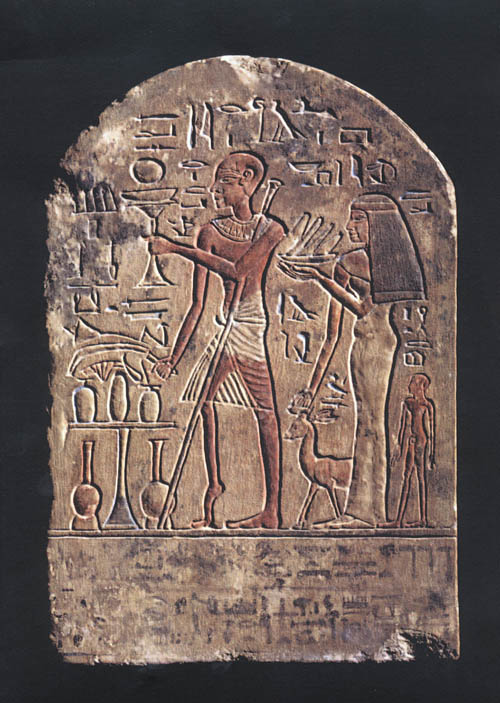


And homosexuality was not the taboo at the time that it is today. There are said to be many scenes of homosexuality in KMT, even amongst the neteru, though I have never seen any. Please don't ask me for references right now because I don't remember where I read this.
[This message has been edited by Osiris II (edited 11 February 2004).]
This is not to say that the condition was not recognized by the Egyptians, but tolerance was taught. In the Instruction of Amenemope at the end of the 2nd millennium BC, a call for justice and forbearance is provided:
Mock not the blind nor deride the dwarf nor block the cripple's path; don't tease a man made ill by a god nor make outcry when he blunders.
We find dwafs in the form of gods, such as Bes. While the Egyptian reasoning for dwarf gods such as Bes is unclear, some have suggested that the belief sprang from an association with dwarfs as familiar protective beings. It is likely that dwarfs benefited socially from their resemblance to these gods.
We find examples of dwarfs in skilled positions such as jewelry craftsman as depicted in the Old Kingdom tomb of Mereruka at Saqqara, and in other wall paintings they are shown tending animals, undertaking agricultural work and occasionally as entertainers for high officials. At other times they are shown as serving important households sometimes as entertainers and in other capacities.
One example of a very important dwarf was Seneb, a 4th or early 5th Dynasty dwarf. He was overseer of the palace dwarfs, chief of the royal wardrobe and priest of the funerary cults of Khufu. A fine statue depicts him with his family, including his wife who was of normal stature, and two children. His wife was known to have been a lady of the court and a priestess.
The ancient Egyptians called both dwarfs and Pygmies deneg. In fact, ancient literature and references barely distingquish between Dwarfs and Pygmies. However, Pygmies, probably because they were usually foreign born, did not enjoy the treatment given to dwarfs. They were usually imported from tropical Africa and most often served in the capacity of dancers or acrobats. While dwarfs might be a part of the court, the pygmies were entertainment for the court, but valued in this respect. A letter from Pepy II of the 6th Dynasty urges Harkhuf, who was on his way back from an expedition to the south of the Sudan, to take great care of the dancing pygmy he had acquired. The letter states that, 'My majesty desires to see this pygmy more than the gifts of the mineland (Sinai) and of Punt'."



Also here is an image of the 'Queen of Punt' from Hatshepsut's mortuary temple in which she detailed her expidition to Punt:
[img] http://digilander.iol.it/camdic/Queen_punt_WEB.jpg [/img]
------------------
Nesu.t-bi.t neb-taui Neb-Maa't-Re sa-Re Amen-hotep
[This message has been edited by Neb-Ma'at-Re (edited 12 February 2004).]
[This message has been edited by Neb-Ma'at-Re (edited 12 February 2004).]
[This message has been edited by Neb-Ma'at-Re (edited 12 February 2004).]
[This message has been edited by Neb-Ma'at-Re (edited 12 February 2004).]
"Queen Of Punt Syndrome? T.I. Farag1, M.A. Sabry2, A. Iskandar3. 1) Dalhousie University, Halifax, NS, Canada; 2) Harvard University, Boston, Massachusetts, USA; 3) Purdue University, Hammond, Indiana, USA.
Critical bioanthropological and medico-genetic dissection of ancient art and mummies is a fascinating emerging discipline. In Cairo Museum, a relief (#11465) from Queen Hatshepsut’s tomb (c.1479-1457 B.C.) in Deir el-Bahari shows the Queen of Punt(Somalia) with a lined face, hyperlordosis, corpulent body, gluteofemoral obesity and apparent symmetrically distributed hamarto-neoplastic swellings on the trunk, arms and thighs, sparing her face, neck, hands and feet. The portrait of her daughter, on the same relief, shows a similar posture. In the absence of the Queen’s mummy (died nearly 34 centuries ago), there is insufficient substance, too much speculation and too few facts to decide the precise diagnosis.
Here we review different hypotheses regarding the Queen’s characteristic phenotype including artistic pseudopathology, racial steatopygy, filariasis, myxodema, rickets, bilateral congenital hip dislocations in addition to the following 8 monogenic disorders: Achondroplasia, Dercum disease, lipodystrophy, Launois-Bensaude syndrome, Neurofibromatosis, familial obesity, Proteus syndrome and X-linked dominant hypophosphatemic rickets (MIM 100800, 103200, 151660, 151800, 162200, 164160, 176920, 307800).
It seems that the Queen’s portrait represents a truly unique phenotype which, if accepted as a new entity, can be coined as Queen of Punt Syndrome. Syndromologists are invited to contribute their expertise to solve the puzzle and help in the precise delineation of the Queen’ s alleged pathological obesity and lumbar hyperlordosis. Acknowledgments: Thanks to Prof. John M. Opitz and Prof. R.Neil Schimke for their valuable comments and contributions. References:
Ghalioungui, P. & El-Dawakly, Z. 1965. Health and Healing in Ancient Egypt. Cairo: Dar Al-Maaref.
Kunze, J. & Nippert, I. 1986. Genetics and Malformations in Art. Berlin: Groose Verlaf.
McKusick, V.A. 1998. Mendelian Inheritance in Man (12th ed.). Baltimore: Johns Hopkins Univ. Press."
http://genetics.faseb.org/genetics/ashg99/f803.htm

quote:There are Old Kingdom statues of deformed men, not just dwarves but people with scoliosis and other deformities. I'll have to find them, but if I can I'll post them.
Originally posted by imhotep:
Did the AE's leave drawings (or at the very least mention)that depicted Kemetians with abnormalities such as dwarfism, gigantism and albinism. If not (considering the fact that they "noticed" phenomena such as homosexuality)...why?